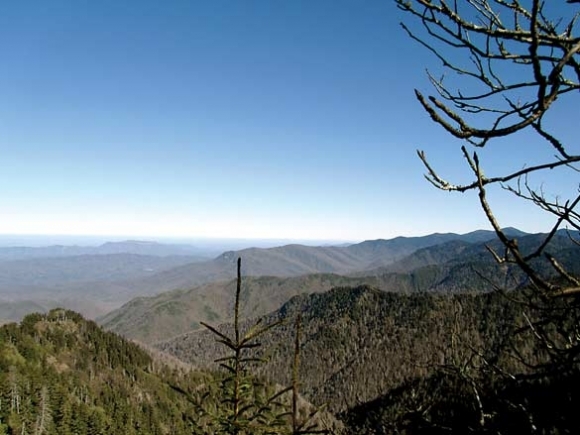A search for Horace Kephart’s alcove

The setting for Horace Kephart’s posthumous novel Smoky Mountain Magic (2009) is the Cherokee Indian Reservation, Bryson City and Deep Creek — places familiar to most readers of this column. The main character, John Carrabus, spends much of his time camped in a hideaway named Nick’s Nest (a real place adjacent to the well-know Bryson Pace) where there’s a rock overhang he calls “The Alcove” and an immense cavern in which he becomes trapped.
As described by Carrabus, Nick’s Nest “is a V-shaped trough 300-400 feet deep and about half a mile long, from a swamp at its mouth to the cliffs above the Pullback Trail. Locals know the area by the name “Dog-eater holler.”
Since I am presently co-authoring a biography of Kephart, I felt like I needed to find out for sure whether or not there is in actuality a cavern or an alcove in Nick’s Nest. So I commissioned Mike Knies, a backcountry explorer who lives in Asheville, to check it out and send me a report.
“I proceeded downward and then up to the second knob. The slopes dropped sharply on both sides. I sat down on a log to eat lunch facing north and the high ridges of the Smokies and again reconnoiter. It was exactly noon I had a better view to the north being a little further out from the ridge behind and one peak on the skyline stood out like a pyramid but I was not sure which it was. I opened a can of smoked trout and promptly spilled the contents while trying to drain it. I still was able to rescue most pieces and made a meal of it, a small crushed pack of Doritos and half a Sun Drop. I almost dropped my GPS down the slope and it would have rolled long way!
“I marked a point further down the ridge that was about halfway between where I started and the Deep Creek Trail. That point was where I would switch back. I went steeply downward in that direction and then made the turn. At that point I was less than 500 feet from the Deep Creek Gap Trail which had turned back eastward and was closer than my ultimate destination. As I went back up the valley I made sure to gain a little elevation as I went so as not to get too close to the stream since I would be coming back that way. I had seen almost no jutting rocks at all but finally realized I was standing on a slight outcrop. It was solitary and there was no alcove below it. The way back was mostly rhododendron and hemlock and pine blowdowns clogged but there were brief open spaces. The slope was steep and I slipped, struggled and climbed rejoicing in the too short open places but always looking for “brown” rather than “green.”
“I saw a large rock proturbence just below and slid slowly down to inspect, hoping it might be the alcove. The rock was 20 feet tall and a large portion had sheared off leaving a 5-foot-wide crevasse between. I slowly made my way through. The jumble of rock at the bottom for some reason reminded me of something that a den of snakes might be hiding in. I have never seen a jumble of writhing snakes. In fact I rarely see snakes at all despite old-timers referring to them. I have heard that the hogs will eat snakes and keep the population down. Of course I don’t hike much in the warmer months when they are out. Anyway I cautiously made my way across, disappointed that it was not something more substantial. I marked it as Nick CLF on the GPS. I continued and when I got to the point below the high knob I was only about 220 feet from the point I had entered the Nest. I felt that my view from that point had eliminated any possibility of extended cliffs or overhangs in between.
Related Items
“I decided that staying close to the creek would cross too much dog hobble so I would walk the creek or try the south side, which on the way up had looked more open along the stream. I scrambled down to the stream and the water again filled my shoes and socks. I had exchanged Boltar for my collapsible hiking pole to add stability in the stream. I knew I would have some slippery rock drops to deal with. I sloshed forward and then realized that the stream would have to drop about 300 feet in less than four-tenths of a mile. There would have to be many steep and long cataracts that would be impossible to descend. I thought I heard one already. I tried the south bank, but it didn’t look promising so I went back to the north side. The hobble was thick. I kept looking up both slopes for cliffs and crevasses. I could see from the now steep slope in front of me that there must be a nice waterfall or series of falls but I could not safely get back over to take a good picture. So I skirted the hobble for a more advantageous spot. I finally got a shot of part of a 30-foot tumble.
“I advanced down and came to a ledge running from the water across and up the slope. I could have worked around it up the slope but decided to try to drop off it. The shortest spot was still about 8 feet. I worked my way down to the edge as I didn’t want to slide off unintentionally. I sat on the muddy edge in a crouch and then dropped my legs off and then the rest. The landing zone was unobstructed so I jumped successfully. Now I could see a much larger rock face but there was no alcove or even space to spread a sleeping bag under cover of an outcrop. I marked this spot as Nick CLF2. There was a huge poplar tree in front of the short cliff. I put my hiking stick which extends to about 4 feet across it and it was wider still. While it wasn’t an alcove this location was flat and clear. I realized that I had left a leather glove when I had rested a second after leaving the stream back when but I could not likely find it easily. So I made another approach to the stream to photograph a cascade. From there I pretty much picked the easiest way down through brown areas, which required staying about 100 to 150 feet from the stream. There was still a lot of rhodo with the intermittent blowdowns but no problem.
“I was disappointed that I had not found something more “earthshaking” in Nicks Nest but I was great fun and interesting, especially since I knew no one else maybe since Kephart himself who had been in there.”
Oh well, negative evidence is better than no evidence at all.
(George Ellison is a naturalist and writer. He can be reached at This email address is being protected from spambots. You need JavaScript enabled to view it..)









